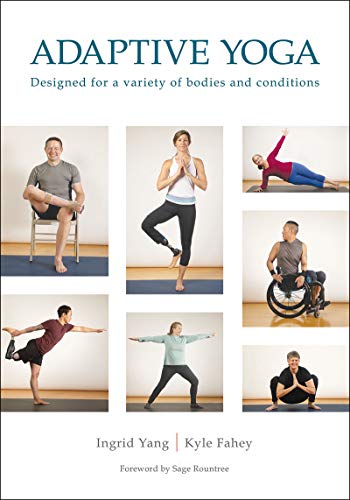Adaptive Yoga
Full Title: Adaptive Yoga
Author / Editor: Ingrid Yang and Kyle Fahey
Publisher: Human Kinetics, 2020
Review © Metapsychology Vol. 24, No. 52
Reviewer: Beth Cholette, Ph.D.
One of the current trends of yoga instruction is a move towards greater inclusivity and equity. Previous titles such as Accessible Yoga (Jivanna Heyman, 2019), Yoga for Everyone (Dianne Bondy, 2019), and Every Body Yoga (Jessamyn Stanley, 2017) have sought to bring the practice of yoga to a wider audience. The current offering, Adaptive Yoga: Designed for a variety of bodies and conditions, is a welcome addition to this growing field.
Authors Ingrid Yang and Kyle Fahey take a somewhat different approach. While the prior volumes have centered mainly around presenting each posture and then describing a number of variations or modifications, Yang and Fahey organize their work around specific conditions, which is more in the tradition of books like Yoga as Medicine (Timothy McCall, 2007) and Yoga for Wellness (Gary Kraftsow, 1999). In their Introduction to this manual, the authors note that within each chapter, the postures are categorized by function (e.g., strength, balance) as well as major muscle groups addressed. The reader – which may be a yoga teacher or yoga practitioner – is encouraged to create a custom sequence of poses that fits the needs of the individual.
The book opens with “Part I: Principles of Adapting Yoga.” The first chapter, “Yoga as Rehabilitation,” gives some basic statistics about people with disabilities (PWD) and offers some background about why yoga is an effective rehabilitation tool, including poses, pranayama (breathing practices), and mindfulness. The authors also review key components of adaptive yoga, not only use of breath and mindfulness but also the importance of props, and unstable surfaces. The following chapter, “How the Body Moves,” presents an overview of movement-based anatomy and includes a number of simple illustrations depicting key muscle groups.
Part II, “Adapting Yoga for Specific Disabilities,” is composed of nine total chapters, covering common complains (low back pain, osteoarthritis, rheumatoid arthritis), injury-based conditions (amputation, spinal cord injury), and illness/disease (Parkinson’s, stroke, multiple sclerosis, cerebral palsy). The format for each chapter is to provide a general overview of that condition, to offer general guidelines for practice, and finally, to describe a series of specific postures. The pose breakdowns are illustrated by color photographs, a combination of half-page and inset photos. The accompanying text instructions are written in a straightforward manner with just enough detail. The pose subheadings cover Benefits, Precautions, Before You Begin, How To [numbered steps for practicing the pose], Modifications, and Variations.
Props are a vital aspect of performing adaptive yoga postures. Those shown throughout the book include a yoga mat, yoga blocks, yoga straps, yoga bolsters, and a folding chair; a few chapters also include use of a foam roller and a step stool. (Athough not mentioned by the authors, common household objects can often be substituted for traditional yoga props.) In addition to yoga asana (physical postures), a number of chapters incorporate additional yogic elements such as breathing and chanting.
Adaptive Yoga concludes with a helpful Glossary that is unusual in that it is organized by chapter, allowing readers to look up any unfamiliar terms in a particular area. Finally, this book would not be nearly as remarkable without the outstanding models depicted within. Each chapter features a model with that condition. The models span all ages and genders, with people well over 50, two different people with two different lower limb amputations, a person using a wheelchair, and even a child of about 7 or 8 years old. (A bit more body size diversity would have been even more inclusive; while likely to be useful to those in larger bodies, this work did not focus on body size per se.)
Authors Yang and Fahey are careful not to present their work as prescriptive, although some readers might view Adaptive Yoga in this manner. Similarly, some might believe that this book is not applicable to them if they don’t have one of the named conditions. Yet this is a truly useful resource for guiding any yoga practitioner towards a more functional yoga practice, one that is adapted to their own body. As a yoga teacher who strives to be accessible to all bodies and all abilities, I am pleased to have acquired this manual for my own home library.
Beth Cholette, Ph.D., is a clinical psychologist who provides psychotherapy to college students.
Categories: Wellness
Keywords: Adaptive Yoga

